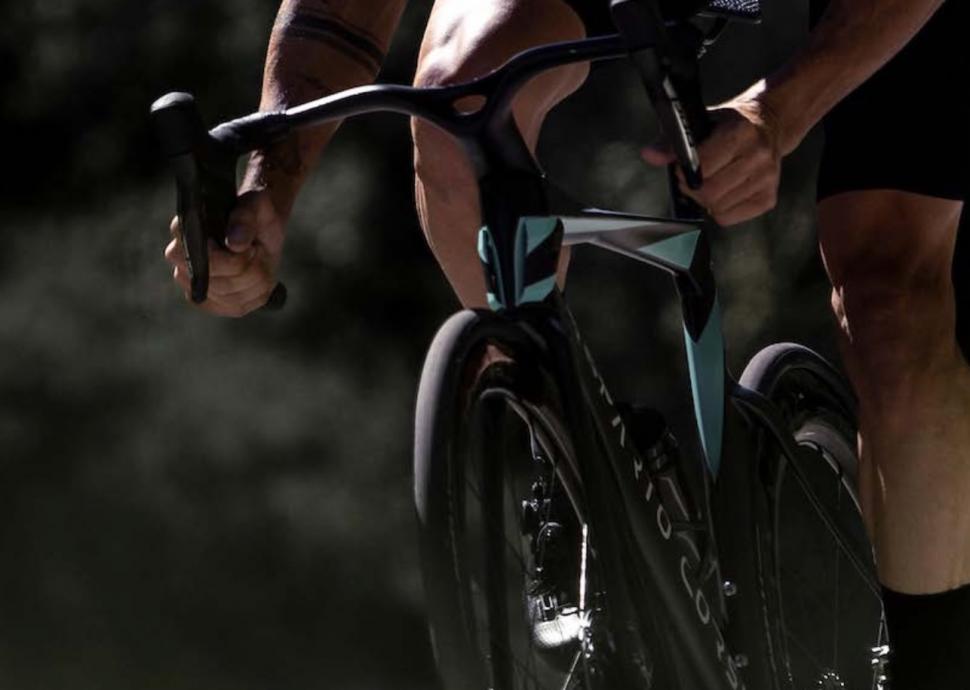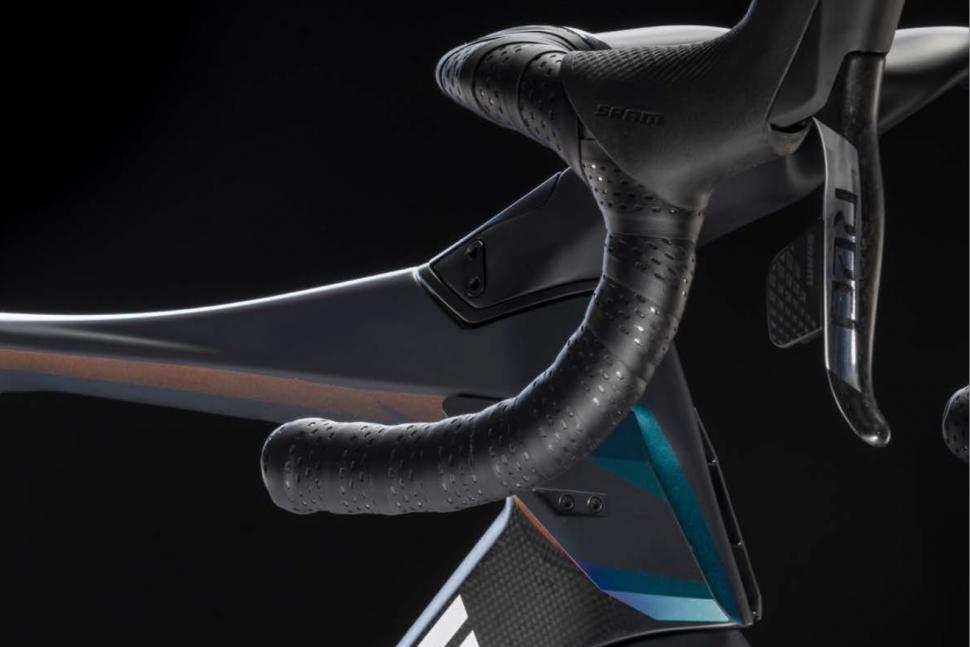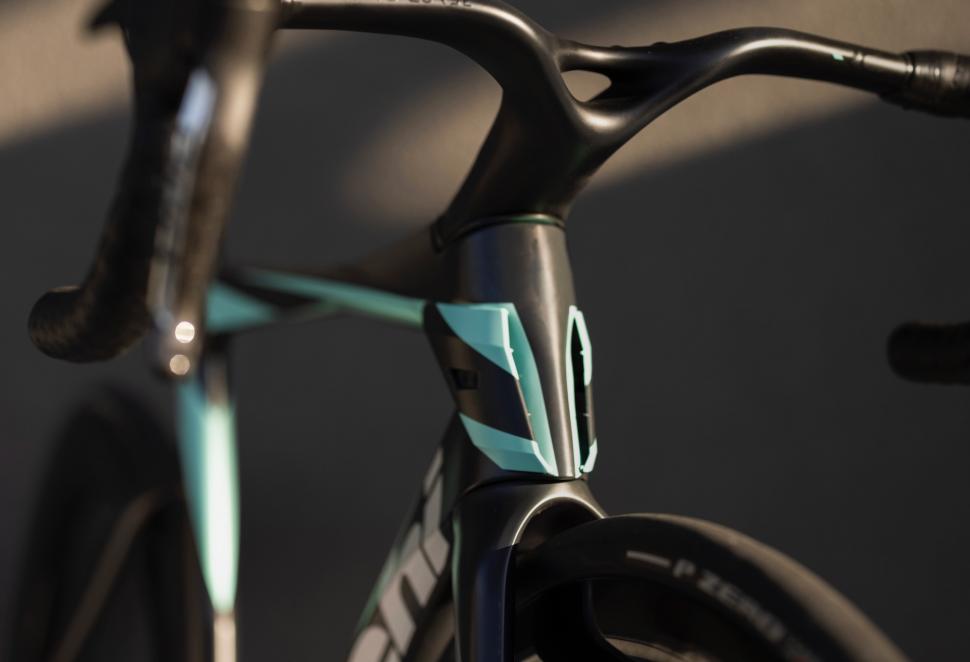- News
- Reviews
- Bikes
- Components
- Bar tape & grips
- Bottom brackets
- Brake & gear cables
- Brake & STI levers
- Brake pads & spares
- Brakes
- Cassettes & freewheels
- Chains
- Chainsets & chainrings
- Derailleurs - front
- Derailleurs - rear
- Forks
- Gear levers & shifters
- Groupsets
- Handlebars & extensions
- Headsets
- Hubs
- Inner tubes
- Pedals
- Quick releases & skewers
- Saddles
- Seatposts
- Stems
- Wheels
- Tyres
- Tubeless valves
- Accessories
- Accessories - misc
- Computer mounts
- Bags
- Bar ends
- Bike bags & cases
- Bottle cages
- Bottles
- Cameras
- Car racks
- Child seats
- Computers
- Glasses
- GPS units
- Helmets
- Lights - front
- Lights - rear
- Lights - sets
- Locks
- Mirrors
- Mudguards
- Racks
- Pumps & CO2 inflators
- Puncture kits
- Reflectives
- Smart watches
- Stands and racks
- Trailers
- Clothing
- Health, fitness and nutrition
- Tools and workshop
- Miscellaneous
- Buyers Guides
- Features
- Forum
- Recommends
- Podcast
TECH NEWS
 2023 Bianchi Oltre RC Air Deflector - 1
2023 Bianchi Oltre RC Air Deflector - 1Bianchi’s new Oltre ‘Air Deflector’ tech isn’t UCI legal
The ‘Air Deflector’ technology that Bianchi has included on the new Oltre road bike that it announced last week cannot be used in UCI-sanctioned events, reports Cyclingnews.
We showed you Bianchi’s radical new Oltre last Tuesday and the Air Deflector airflow channels on the sides of the head tube attracted a whole lot of attention.
> Bianchi unveils radical new Oltre road bike with ‘Air Deflector’ aero tech
Bianchi says that the design was “inspired by the world of motor racing at the highest level to optimise aerodynamic efficiency in every situation”.
“[We] designed and integrated Air Deflectors (patent pending) into the sides of the head tube, thus channelling airflow and creating a low-pressure zone at the rear of the tube,” says Bianchi.
“The action of the deflectors complements the performance of the new aero cockpit, which generates low-pressure air vortices directed towards the legs of the moving athlete through a centrally located hole.
“The result is a significant reduction in aerodynamic resistance by the athlete-bike system, as certified by wind tunnel testing. In short, results proved higher speed with less effort.”
That’s a big promise. However, Cyclingnews reports that the UCI has said, “The Bianchi Oltre RC was presented and homologated without the so-called deflectors. Therefore the use of the mentioned parts will only be possible outside of UCI-sanctioned events.”
The Oltre that has been added to the UCI’s List of Approved Models of Framesets recently is described as the ‘Oltre Zero Pro-RC’.
This is a little confusing in that Bianchi announced three new Oltre platforms last week: the Oltre RC, the Oltre Pro, and the Oltre.
As mentioned above, Bianchi has described the Air Deflectors as being “integrated” although the UCI suggests that approval was made for the bike without their inclusion.
Companies don’t need to send bikes to the UCI for inspection to receive approval. Submitting the designs so that the UCI can check they conform with the rules is sufficient; no safety testing is involved.
Bianchi says, “Compared to the previous Oltre XR4 model, the Oltre RC saves 17 watts at a speed of 50km/h (31mph) and gains 45 seconds over a distance of 40km (25 miles) with a power output of 250 watts/h.
“In variable wind conditions, the advantage over the best aero bikes on the market increases by 30 percent, ensuring extreme performance even during sudden changes in wind direction.”
For clarity, that statement doesn’t imply that Bianchi says the Oltre RC offers a 30 percent advantage over the best aero bikes on the market. Rather, it says that the advantage over the best aero bikes – which could be tiny for all we know because Bianchi hasn’t released comparative figures – increases by 30% in variable wind conditions.
Supposing Bianchi claimed its Oltre RC offered a 1% advantage over the best aero bikes from competitors – this is just a 'for instance' – that would increase to 1.3% in variable wind conditions, according to the claim. That’s a side issue, though.
The UCI hasn’t cited exactly how the Oltre falls foul of the rules although article 1.3.024 of its Cycling Regulations says, “Any device, added or blended into the structure, that is destined to decrease, or which has the effect of decreasing, resistance to air penetration or artificially to accelerate propulsion, such as a protective screen, fuselage form fairing or the like, shall be prohibited.”
The Clarification Guide of the UCI Technical Regulation says, “Aerodynamic assemblies and protuberances on the head tube or elsewhere are prohibited.”
What does Bianchi have to say about all this? It confirms that the Oltre has been approved by the UCI without the addition of the Air Deflectors but that the frame is prepared to mount this component, so they’re perhaps not as ‘integrated’ as we might have been led to believe.
Mat has been in cycling media since 1996, on titles including BikeRadar, Total Bike, Total Mountain Bike, What Mountain Bike and Mountain Biking UK, and he has been editor of 220 Triathlon and Cycling Plus. Mat has been road.cc technical editor for over a decade, testing bikes, fettling the latest kit, and trying out the most up-to-the-minute clothing. He has won his category in Ironman UK 70.3 and finished on the podium in both marathons he has run. Mat is a Cambridge graduate who did a post-grad in magazine journalism, and he is a winner of the Cycling Media Award for Specialist Online Writer. Now over 50, he's riding road and gravel bikes most days for fun and fitness rather than training for competitions.
Latest Comments
- Aluminium can 5 hours 10 min ago
So there's electronics and computers and motors for gear changes and pumping up or deflating tyres. Why not just motorise the whole bike and be...
- ktache 7 hours 7 min ago
Quest are showing the Paris Roubaix highlights at 11 both days.
- chrisonabike 7 hours 51 min ago
Pretty sure a lot of that "more space for motor vehicles" was because fewer motor vehicles (also marginally "smaller motor vehicles")....
- David9694 8 hours 38 min ago
I get the impression he represented himself, came over as a bit of an ass and received a ban, when a lawyer might have got him spared that.
- Rendel Harris 8 hours 41 min ago
Well if you ever get the chance and you feel yourself flagging give me a shout, happy to put in a shift.
- Laz 8 hours 49 min ago
OMG- that's so self centred....what about the brotherhood and sisterhood of enjoying a ride and sharing a happy wave with a fellow rider out...
- thax1 9 hours 16 min ago
Cycliq certainly seemed to let a lot of people down in the early days. I held off until the 12 Sport came out, but have been impressed....
- ktache 9 hours 18 min ago
My better half seems to like giving me pressies of Rapha clothing. I am wearing their casual hoodie right now, and very nice it is too. First off...
- thax1 9 hours 28 min ago
Push on through foot numbness and you then arrive at agonising foot cramp....
- Destroyer666 10 hours 5 min ago
Oh dear, to your own lack of understanding. I was not referring to your vague generalisation of "people", I was referring to a particular...




Add new comment
9 comments
I'm still confused that they say they cause a low pressure area behind the head tube. My rudimentary understanding of aerodynamics is that drag is caused by (relative) high pressure in front of a moving body and low pressure behind the body. If these work I would have thought they channel air into the low pressure area behind the tube unless they are claiming that this low pressure area is somehow maintained to reduce the amount of air hitting the seat tube?
Either way it was obvious last week that they weren't integrated (you could see the bolts holding them on) and that the UCI would allow it.
I think the key to their claim of improved efficiency lies in "generates low-pressure air vortices directed towards the legs of the moving athlete". It's claiming to create a low-pressure area in which the cyclist's legs are operating; if this is true (and that strikes me as a very big if) it obviously would be a great advantage, given that a cyclist's legs are going to be 20 or 30 times the width of the tubes.
If these were in fact integrated as part of the headtube, I fail to see the fundimental difference between this and a cervelo triangular handlebar stem.
Presumably because the Cervelo bars are designed to let the air flow through the setup with as little resistance as possible, whereas these are designed to deflect air away from the setup, so moving more towards a fairing.
I was puzzled when I first saw the announcement, because I thought UCI rules banned that sort of thing, but I don't race and I'm not in the market for a €13,800 bike.
If you don't care about racing and just want an aerodynamic bike, get a faired recumbent.
If you want your bike to be suitable for training for UCI events and like the idea of making it slightly faster when not racing and the bike is competitive without the deflectors, then sure why not, but it seems a lot of fuss about a relatively pointless gimmick.
The removeable plastic bits were super marketing material. Proof is in the above article. Top marks Bianchi
And the problem is?....... if it is UCI legal without the deflectors.... then what is the issue?..... if they can be fitted as an accessory by non race owners , then fair go......
FTFY
Cycling world drops dead in shock due to UCI decision we can all agree on.